

![]()
![]()
|
Newsletter of the District of Asia Jan - June 2006 On Rome and the Society of Saint Pius X A
Joint Statement from The
Remnant and Catholic Family News
|
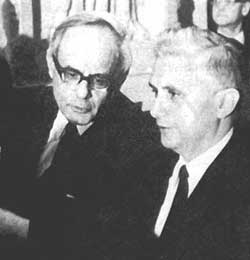 |
|
| Pope
Benedict XVI’s solution to the present problems of the Church
is to go back to discover again the true teaching of Vatican
II. On this photo we can see Fr. Ratzinger and Fr. Rahner
during the Council as major and most radical theologians inspiring
the Bishops. |
The fact that this December 22 speech denounced the “hermeneutic of discontinuity and rupture” is nothing on which to pin much hope. For years, Cardinal Ratzinger has lamented various bad interpretations of the Council. But Cardinal Ratzinger’s solution has never been a return to pre-Vatican II tradition. Rather, time and time again, his answer is to go back to discover the “true” teaching of Vatican II. Cardinal Ratzinger’s —and now Pope Benedict XVI’s — solution to the present upheaval is to return Catholics to the same liberal, ambiguous Vatican II documents that produced the crisis in the first place.
A return to Qttas Primas, a return to the Oath Against Modernism, a return to Blessed Pius E’s Syllabus of Errors plays no part in any “restoration” Pope Benedict may advocate. The Benedict XVI of today is the same Cardinal Ratzinger of yesterday. The New Theology of Vatican II is still the center of his universe.
Thus, the question forms on the lips of concerned Catholics: How would a “reconciled” SSPX be able to operate freely under the aegis of the modernist New Theology, when the entire reason for the SSPX’s existence is to publicly oppose this destructive New Theology?
This indeed is a sticking point, and one that would be fatal for the SSPX to compromise on in any way. Yet there seems little doubt that the SSPX would be expected to “give a little” to the Vatican regarding acceptance of the Council.
There can be no question that the SSPX (which is not in formal schism as even admitted by Cardinal Castrillon Hoyos of the Pontifical Commission Ecclesia Dei, and which is not sedevacantist) cannot maintain its “irregular” canonical status indefinitely. Ultimately, the SSPX will return to Peter’s full embrace, presumably after Rome has abandoned the failed policies of Vatican II, something we are convinced must (and will) happen in God’s good time.
It is our considered opinion, however, that the “state of emergency” at this point, far from having subsided, has become so firmly entrenched in the human element of the Church that nothing short of divine intervention can restore Holy Mother Church. We are, as the late Michael Davies noted shortly before his death, “beyond crisis” since the Church is no longer even able to generate the priestly vocations necessary to provide the faithful with the sacraments. The rise in the number of “priestless parishes” is a grim reminder of this reality.
Vatican II
After Bishop Fellay’s August 29 meeting with Pope Benedict XVI, Cardinal Francesco Pompedda, the former prefect of the Apostolic Signatura, told the Italian daily La Stampa that the Society of St. Pius X could only be reconciled to the Holy See if it recognizes the validity of Vatican II decrees.
Likewise National Catholic Reported John Allen — somewhat inaccurately — listed the “four conditions posed by the leadership of the SSPX for reunion: 1) Wider permission for celebration of the pre-Vatican II Mass; 2) lifting the excommunications for the four bishops consecrated by Archbishop Lefebvre in 1988; 3) recognizing a right to criticize certain aspects of Vatican II, especially its teaching on religious liberty; 4) a canonical structure to provide traditionalists with some autonomy, such as an apostolic administration.”
Regarding the first two points: the Society of Saint Pius X is not requesting a more widespread “permission” for the Tridentine Mass, since no such permission is necessary. The SSPX merely wants, as does every true Catholic, the Vatican to admit the truth that the Tridentine Mass has never been forbidden and all priests are free to celebrate it without a special “indult” from the bishops.
In similar vein, the SSPX is not asking the Vatican to “lift” the excommunications of 1988, since the SSPX does not recognize any such excommunications exist. Again, the SSPX only wants Rome to admit the truth of the situation and declare the excommunications null.
Further, the SSPX does not pose these first two points as a condition for reunion, but only as a condition for starting negotiations that may lead to regularization. But the SSPX first asks that the Vatican speak honestly about these two important points. If the Vatican is not willing to admit the truth — and if any organization has a duty to admit truth, it is the Vatican — then negotiations are rather useless.
Regarding the all-important third point, which would be an absolute condition of the SSPX for regularization, John Allen wrote, “One Vatican Cardinal who spoke to NCR February 2 said he doubted the Holy See could accept the conditions posed by the Society for returning, especially a right to disagreement with elements of Vatican II. ‘That would have very serious implications for the unity of the Church,’ the Cardinal said. The unnamed prelate further stated he believes the Pope ‘understands this very well’ and would thus be cautious about moving forward.”6
Attachment to the Rome of Yesterday?
Pope Benedict XVI, however, has not been cautious about moving forward the post-Conciliar revolution. A brief review of some of the most poignant moments of his pontificate shows him as a man with little “attachment to the Rome of yesterday.”
-
At Pope John Paul H’s funeral Mass (see picture right), eleven days before he was elected Pope, Cardinal Ratzinger gave Communion in the hand to Brother Roger Shultz of Taize, a man whom he knew to be Protestant. Subsequent news stories reported that this was not the first time Cardinal Ratzinger practiced intercommunion with non-Catholics.7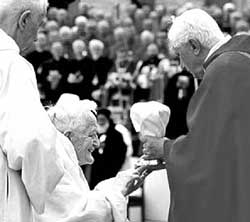
- During the
same Mass, Cardinal Ratzinger spoke of John Paul II “standing
at the window of the Father’s house”, indicating that John Paul
II is already in Heaven, thus virtually bypassing Purgatory and
providing a kind of instant canonization;8
- In his first Papal homily, Benedict XVI said, “Therefore, in preparing myself also for the service that is proper to the Successor of Peter, I wish to affirm strongly my determination to continue the commitment to implement the Second Vatican Council...” He pledged to continue the ecumenical dialogue championed by Pope John Paul II.9
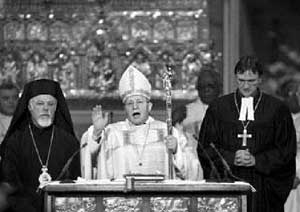 |
| Cardinal
W. Kasper, in charge of ecumenical dialogue with other Christian
confessions: as active as he was before the election of Benedict XVI. |
- In May 2005,
Pope Benedict appointed the liberal Archbishop William Levada
as Prefect for the Sacred Congregation for the Doctrine of the
Faith. Not only has Levada a history of covering up clerical-homosexual
activity in his respective U.S. dioceses, but he was one of the
most ecumenical prelates in the United States. He was the first
U.S. bishop to visit a synagogue after Pope John Paul H’s initial
1986 synagogue visit. Levada also sponsored “Spirit of Assisi”
events in his cathedral, which included Jews, Muslims, Buddhists,
Hindus and other sects.10
This is the same Archbishop who told Father Eugene Heidt that
Transubstantiation is a “long and difficult term” and “we don’t
use that term any more”.11
Yet Levada is the man hand-picked by Pope Benedict to be the alleged
“doctrinal watchdog” of the Church worldwide. Levada was also
allowed to name his own successor in San Francisco — Bishop George
Niederauer — a man who just recently praised the homosexual film
Brokeback Mountain.
- On May 13,
2005, Pope Benedict placed the beatification of Pope John Paul
II on the fast track by bypassing the prudent five-year waiting
period. This can only serve to “canonize” Pope John Paul H’s disastrous
pan-religious policies; the revolution is preparing to canonize
its own.
- On August
17, Pope Benedict practically canonized the murdered Protestant
Brother Roger of Taize in a public speech, calling him a “faithful
servant” of the Lord who is now “in the Hands of Eternal Goodness”.12
- On August
19, Pope Benedict visited a synagogue in Cologne for the purpose
of interreligious relations, not for the purpose of exhorting
Jews to convert to Jesus Christ; this he did in Cologne while
a million young people from around the world had converged on
that city for World Youth Day. (How does one begin to evaluate
scandal on such a scale?)
- On the same day, Pope Benedict gave an address at an ecumenical meeting in which he spoke of ecumenism as a good thing that does not have as its goal a “return” of non-Catholics to the one true Church of Christ, thus undermining the infallible Catholic dogma, “Outside the Church there is no salvation”(see picture below);13
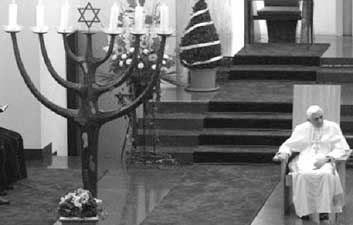
Some
meaningful moments of the visit of Benedict XVI to the Synagogue
of Cologne:
above while he is listening to the sermon of the Rabbi;
below, receiving gifts from the Jews.
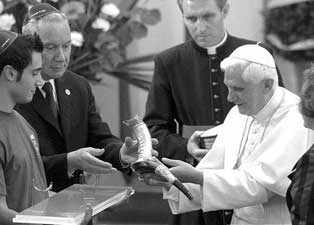 |
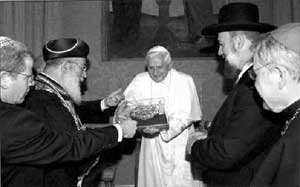 |
|
|
|
|
- Pope Benedict,
in October of 2005, lauded Father Hans Urs von Balthasar at a
conference honoring this liberal theologian.14
Von Balthasar taught, contrary to the clear teaching of Scripture,
that a Catholic may “hope” that all men are saved. Thus the Pope
gave unqualified praise to the man who, in effect, was one of
the world’s foremost proponents of universal salvation;
- Under Pope
Benedict XVI, the Catholic doctrine of Limbo is being “re-studied”,
and is likely to be jettisoned as outdated teaching. This undertaking
by a Commission of theologians under the Sacred Congregation for
the Doc trine of the Faith enjoys Pope Benedict’s full support.
This comes as no surprise, since Cardinal Ratzinger himself previously
indicated his own disbelief in Limbo, saying he would “let it
drop”. News of Pope Benedict’s Commission on Limbo even rattled
conservative Novus Ordo priests.15
- On November 29, 2005,16 Pope Benedict issued a pathetic document on Seminary formation that, for the first time in Church history, said that those who engage in homosexual activity should be “profoundly respected”; the document allows a homosexual to become a priest provided he has been celibate for three years. This led a number of Novus Ordo Catholics to regard Pope Benedict as even more liberal than Pope John XXIII in who in a 1961 document banned homosexuals from the priesthood because of their “evil tendencies”.
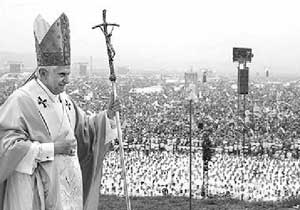
More examples could be given but we think the point is made. To repeat Bishop Fellay’s wise criteria, for any reconciliation of the SSPX with Rome to be possible, Rome must give “clear proof of its attachment to the Rome of yesterday”. Pope Benedict XVI has shown that this criteria for a return to Tradition does not exist. Even non-Traditionalist publications lament this aspect of Pope Benedict’s pontificate.
Dale Vree, editor of the New Oxford Review, did not conceal his disappointment with the Pope’s first nine months:
“This document [on homosexuals in the seminary] is Pope Benedict’s defining moment, and he flubbed it. Likewise, his appointment of William Levadato be Prefect of the Congregation for the Doctrine of the Faith was the most important appointment Benedict would make, and he flubbed that, too.”
After noting that Pope Benedict’s cordial four-hour visit with Hans Küng only served to give respectability to Küng’s heretical ideas and projects, Mr. Vree said:
“The latest outrage is Benedict’s appointment of Bishop George Niederauer to be Archbishop of San Francisco. Niederauer is clearly ‘gay’-friendly. He pastored a parish in West Hollywood with a large ‘gay’ congregation, where he said that homosexuals are ‘wonderful’. As Bishop of Salt Lake City, he opposed a constitutional ban on same-sex marriage. He denies that there is a link between homosexual priests and the molestation and rape of boys. He helped found the Coalition of Concerned Religious Leaders in Utah, which supports ‘tolerance’ for homosexuals. Topping it off, he has been praised by Sam Sinnet, head of Dignity-USA, and Francis DeBernardo, head of New Ways Ministry — both groups being composed of proud ‘gay’ lesbian Catholics.”17
Mr. Vree’s complaint is all the more warranted when we consider that Joseph Cardinal Ratzinger was Prefect of the Vatican’s Congregation for the Doctrine of the Faith for twenty-four years and must have known the history of this gay-friendly bishop! Yet Bishop Niederauer is the man he appointed to head — of all places — the diocese of San Francisco.
Thus at a time when even conservative Novus Ordo Catholics see the downward spiral of Pope Benedict’s pontificate, it behooves the Society of Saint Pius X to proceed with extreme caution in any negotiations with a Pope who has failed to show “with actions that speak louder than words that there must be no innovations outside of Tradition”. Under such a Pope, it seems clear that the future of the SSPX could not be guaranteed.
Let us make one thing clear: Our position vis-a-vis rapprochement between the SSPX and the Vatican is here premised on the presumption that the SSPX is not in schism. Were the SSPX in schism then their bishops and priests would, objectively speaking, be guilty of the mortal sin of schism and we would have no truck with that. As has been vigorously contended since 1988, however, the canonical standing of the SSPX, though admittedly “irregular”, has never risen to the level of formal schism. The priests of the SSPX pray for Pope Benedict as well as their respective local ordinaries in every Mass they offer; the bishops of the SSPX have no territorial jurisdiction and so have gone to great lengths to avoid even the appearance of establishing the “petite eglise”; the SSPX has never denied the Pope’s authority, but, rather, citing provisions out of the new Code of Canon Law itself for legal recourse that can be taken in the case of necessity, the so-called “state of emergency” clause, have chosen to withhold obedience to that which would compromise the Faith itself. In addition to this, however, there has been no stronger defender of the modern popes against the charges of the so-called sedevacantists than the Society of St. Pius X. That there is not (and never was) formal schism in the SSPX has been borne out many times since 1988, most notably, perhaps, by Cardinal Ratzinger himself in 1993 with respect to the case of Pat Merely and the Hawaii Six, and, most recently, by the Pontifical Commission Ecclesia Dei president himself, Cardinal Castrillón Hoyos.
This fact notwithstanding, it is a cause of no small concern that the Pope’s chosen instrument for conducting negotiations with the SSPX happens to be the very same Cardinal Castrillón Hoyos, a man who, in many cases in his dealing with traditional Catholics, seems to have gone out of his way to demonstrate himself as untrustworthy.
Notes:
1.“No Compromise With Vatican, SSPX Leader Says”, Catholic World News, February 7, 2006 (www.cwnews.com/news/viewstory.cfm?recnum=42289) See also “Press Conference of Bishop Fellay to the Journalists for Religious Information”, posted by Did, February 2, 2006 (www.dici.org/actualite read.php?id=747&loc=US).
2. As the motu proprio Ecclesia Dei makes perfectly clear — no SSPX, no Indult!
3. On web at: http://www.sspx.org/Superior%20Generals%20Ltrs/supgen 6.3.htm
4. Jospeh Cardinal Ratzinger, Principles of Catholic Theology, (San Francisco: Ignatius Press, 1989), p. 391.
5. See “An Interview with Bishop Williamson on Pope Benedict XVTs Christmas Address to the Curia”, Catholic Family News, February 2006. On web at: http://www.cfnews.%20org/bw-dec22.htm See also, Christopher Ferrara, ‘“Holy Revolution’ or Wholly Revolutionary”, The Remnant, Jan. 31, 2006. On web at: www.remnantnewspaper.com/Archives/archive-2006-0110-whollyrevolution.htm
6. “The Word from Rome”, John Allen, February 4, 2006. Emphasis added. On web at: http:// www.nationalcatholicreporter.org/word/word020306.htm.
7. “Pope Benedict XVI and Eucharistic Sacrilege”, J. Vennari, Catholic Family News, Sept., 2005. On web at www.cfnews.org/RatzRoger.htm The author also demonstrates that contrary to various false reports, Brother Roger did not convert to the Catholic Faith, but died a Protestant. This was confirmed by the author by means of two telephone calls to the community of Taize, one before Brother Roger’s death, and the other after his death.
8. “Cardinal Ratzinger’s Homily at John Paul’s Funeral Mass”, Zenit, April 8, 2005.
9. Zenit news, April 20, 2005: www.zenit.org/english/visualizza.phtml?sid=69626.
10. “Ecumenical Archbishop Levada to Head Sacred Congregation for the Doctrine of the Faith”, J. Vennari, Catholic Family News, June, 2005. On web at: www.cfnews.org/ LevadaCDF.htm. See also “New San Francisco Archbishop Thinks Gay Propaganda Film Brokeback Mountain is ‘Very Powerful’” , Lifesite, February 13, 2005. On web at: www.lifesite.net/Idn/2006/feb/06021306.html.
11. See Priest Where is Thy Mass? Mass Where is Thy Priest?, (Kansas City, Angelus, 2004), p. 64.
12. “Pope Mourns Murder of Taize’s Brother Roger: Founder ‘Has Attained Eternal Joy,’ Says Benedict XVI”, Zenit, August 17, 2005.
13. Pope Benedict said, “On the other hand, this unity does not mean what could be called ecumenism of the return: that is, to deny and to reject one’s own faith history. Absolutely not!” Ecumenical Meeting: Cologne, August 19, 2005. Address of the Pope on Vatican webpage: www.vatican.va/holy_father/benedict_xvi/speeches/2005/august/documents/hf_ben-xvi_ spe_20050819_ecumenical-meeting_en.html.
14. “Pope Praises Von Balthasar and His Theology”, Zenit, October 10, 2005.
15. For example, see “Can Limbo Be Abolished?”, Father Brian Harrison, The Remnant, Dec. 31, 2005. On web at: www.remnantnewspaper.com/Archives/archive-2005-1215-hmbo.htm
16. In a painful irony, Pope Benedict released this appalling document on the centenary of Archbishop Marcel Lefebvre (Born November 29, 1905).
17. “Homosexuals in the Seminary: Why the Priesthood Will Continue to Become a ‘Gay’ Profession”, Dale Vree, New Oxford Review, February 2006, p. 4.